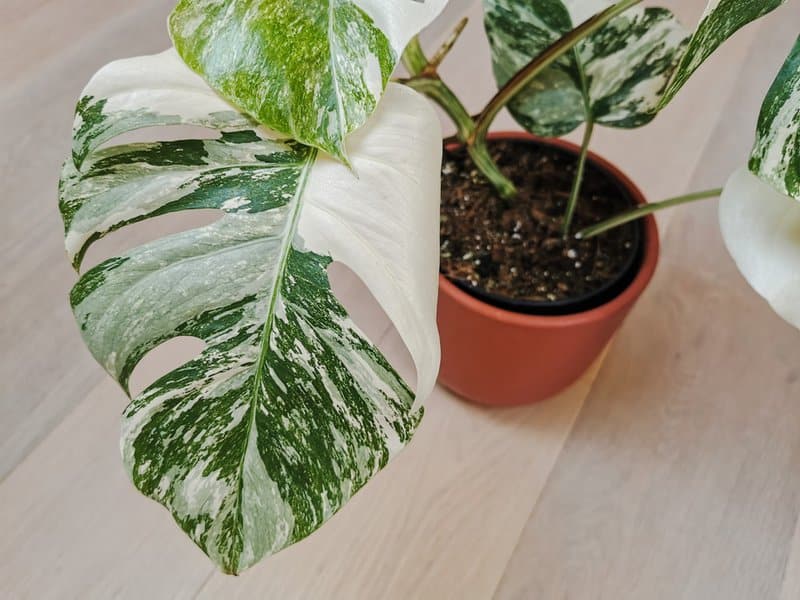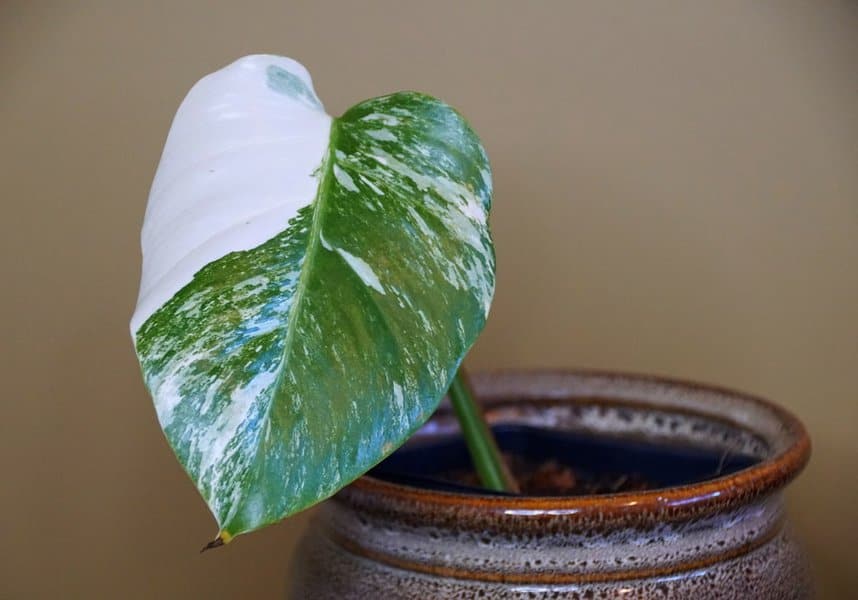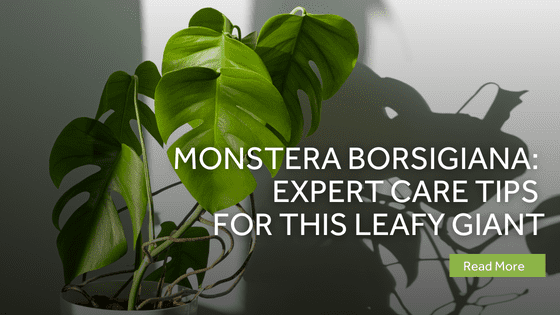Are you a fan of the popular Monstera plants? If so, let us introduce you to a stunning subspecies of the Monstera deliciosa: Monstera borsigiana. Both the Monstera deliciosa and this Borsigiana subspecies have perforated leaves, considerable size, and vibrant green foliage. Read on to become familiar with Monstera borsigiana and what it takes to care for it properly.
Table of Contents
Monstera Borsigiana Overview
The Monstera borsigiana is a subspecies of the famous Monstera deliciosa. That is why the scientific name for this species has three names: Monstera deliciosa Borsigiana. These tropical plants are native to Mexico and Central America and are often known as the swiss cheese plant, wrinkle Deliciosa, and Borsigiana.
Monstera species belongs to the family Araceae, home to many popular plants like philodendrons and aroids. Monstera borsigiana belongs to the genus Monstera and is a subspecies itself.
Different types of Monstera borsigiana include the Monstera borsigiana Aurea, Monstera borsigiana Variegata, and the Monstera borsigiana Albo Variegata.
Monstera borsigiana Aurea: This variety of Monstera borsigiana has yellow variegation contrasting with its dark green leaves.
Monstera borsigiana Variegata: The variegata shows beautiful patterns of stripes, splotches of lime green, and dark green leaves as their canvas.
Monstera borsigiana Albo Variegata: The albo variegated monstera plant has hues of white, as the name suggests. Many leaves have simple white striping, but sometimes the whole leaves are a shade of white.
| Botanical Name | Monstera deliciosa borsigiana |
| Family | Araceae |
| Genus | Monstera |
| Origin | Mexico, Central America |
| Sunlight | Bright indirect light |
| Watering | When the top layer of the soil is dry |
| Soil | Rich, alkaline, well-draining |
| Temperature | 60-80 degrees Fahrenheit |
| Propagation | Stem cutting method |
| Re-Potting | Once rootbound |
| Pests and Diseases | Fungus gnats, spider mites |
| Toxicity | Toxic to humans and pets |

Monstera Borsigiana Features
The Monstera borsigiana has beautiful perforated leaves upon maturity, as many Monstera plants are known for, like the Monstera deliciosa. Many believe that the Deliciosa and the Borsigiana are the same plants, but they are two separate species. The Monstera deliciosa vs Borsigiana debate can be settled by looking at some key differences.
First, the Monstera borsigiana has a faster growth rate than the Monstera deliciosa.
Second, the Monstera borsigiana is smaller than the Monstera deliciosa leaves and plant. The Monstera deliciosa and Borsigiana are well known for their color and broad, swiss cheese plant leaves with holes.
Let’s explore more about the key features of the Monstera borsigiana. The Monstera borsigiana is sometimes called a dwarf variety of the Monstera Deliciosa since the subspecies rarely grow to be taller than 7 feet indoors. The height of the plant can depend on the growing conditions you provide to the plant. In their natural habitat, this tropical plant can reach much taller heights.
The Monstera Deliciosa Borsigiana plant is well-known for its striking leaves. Mature leaves can reach a whopping width of around two feet in the right growing medium. Once mature, you will begin to notice the perforations begin to appear on the Monstera plants.
Monstera borsigiana and Monstera deliciosa both produce flowers and fruit in the right outdoor conditions, but this is unlikely to occur when planted indoors. The Monstera deliciosa got its name partly for the delicious tasting fruit it bears. However, it is important to note that while Monstera fruit might be harmless once ripe, the sap that flows through the plant is toxic to humans and animals due to calcium oxalate crystals.
Related Article: Variegated Monstera Adansonii: Instructional Care Guide
Monstera Borsigiana Care Guide
Caring for Monstera borsigiana is simpler than other Monstera plants, especially when you follow the steps in our care guide. This species, like others, prefers its environment to mimic its natural habitat. Like many tropical plants, this Monstera plant prefers moist soil but not soggy and bright indirect sunlight to get the rays it needs without harming the plant.
Additionally, the Monstera borsigiana enjoys warm temperatures like the tropics, which is something to consider when deciding where to plant or keep. This plant is adaptable to humidity levels and enjoys fertilizing during the growing season. Since the plant has a fast growth rate, proper maintenance and pruning Monstera borsigiana are key to controlling it. Read on to learn more in-depth tips and tricks!
Ideal Growing Place
The Monstera borsigiana can be planted outdoors if you live in the right climate and provide the proper Monstera temperature, soil, humidity, watering, and sunlight conditions. If not, you can successfully grow your Monstera deliciosa Borsigiana plant indoors.
Monstera borsigiana plants look stunning in hanging baskets since this plant has a creeping tendency and will cascade around your space. If you do not want to hang your plants, the best pots for Monsteras are terracotta pots with drainage holes. The terracotta helps soil moisture levels stay regulated and increase air circulation.
The growing season for the Monstera deliciosa Borsigiana plant is during the warmer spring and summer months. During this time, the plant spends more energy and nutrients supporting new growth. Once the colder fall and winter months appear, the plant will slow down, and its growth rate will decline.
Water
The Monstera borsigiana prefers the soil to stay moist but not soggy. Too much water held by the roots can lead to harmful root rot. Avoiding root rot will help your plant as a whole stay happy and healthy.
The top two inches of soil should always stay moist; once the top layer has become dry, it is time to water. During the spring and summer months, when the plant is growing swiftly, it should be watered about once or twice per week.
Once fall and winter approach with a slower growth rate, watering will be needed less. Watering once every two to three weeks is more likely during the dormancy time. Another factor that influences how much water stays in the soil is the type of pot your plant is in. Terracotta or other ceramic pots help the air circulation in the soil and reduce soil moisture, so you may need to water more often.
Sunlight
The natural habitat in which the Monstera borsigiana grows offers plenty of bright indirect sunlight. Therefore, whether you plant your Monstera indoors or outdoors, your plant must receive plenty of light, but nothing direct. Too much sun exposure can make your beautiful foliage scorched and damage the plant.
If planting outdoors, find a bright but shady area for your Monstera borsigiana to grow in. If you are growing your Monstera indoors, find a bright window and place your plant near it. Be sure to rotate your plant often so that all sides receive this light.
Temperature
The ideal temperature range for your Borsigiana Monstera vining plant is around 60-80 degrees Fahrenheit. If your Monstera borsigiana is an indoor plant, this falls nicely in many people’s average home temperatures. If you wish to grow your Monstera outdoors, look ahead of time to see if your climate is suitable in temperature for this range. Bring your plant indoors if your outdoor temperatures fall below the 50-60 degrees Fahrenheit range. Too low of temperatures can cause stress to your plant.
Soil
The best soil mix for Monstera borsigiana is well-draining, rich, and alkaline soil. Well-draining soil is a must-have so excess water can pass through and out towards the drainage holes. Recall that too much water in the soil can lead to root rot and harm your vining plant.
To help your potting mix drain better, you can add various soil amendments such as sphagnum moss, perlite, or coco coir. These additions help the soil retain some moisture without holding too much water. Other key factors include rich soil with organic factors and alkaline soil with a pH range of 7-14.
Humidity
Tropical plants like the Monstera deliciosa Borsigiana love higher humidity levels similar to their native habitats. The ideal humidity level is around 70%, but this species adapts to the indoor spaces’ average humidity. Having a humidifier in the same space as your plant and a pebble tray can offer extra moisture in the air to your plant.
You May Also Like: Best Lawn Sprinkler For Your Garden
Fertilizer
When the plant’s growth rate is at its quickest during the growing season, adding fertilizer to your care routine is recommended. Giving your plant fertilizer offers it extra nutrients to support the extra stem, root, and leaf structure growth. The best fertilizer for Monstera borsigiana is an organic liquid fertilizer rich in nitrogen, potassium, and phosphorus.
Be sure to dilute the strength of your fertilizer and follow the instructions specific to avoid holding too many fertilizer compounds in the soil. During the spring and summer, provide your plant with fertilizer about once a month. Once the dormancy period arrives in the fall and winter, you can stop giving your plant the fertilizer as it is now resting and doesn’t need extra nutrient uptake.
Pinching/Pruning
Due to the fast-growing nature of the Monstera borsigiana, it is necessary to keep up with pruning and maintenance to control the growth. Especially if you are growing indoors, adjusting the height and spread of your plant is helpful. Regular maintenance includes removing dead or dying leaves from your plant to encourage new growth. To learn how to prune Monstera borsigiana, read on.
The best time to trim Monstera borsigiana is during the spring and summer when it is quickly growing. Be sure to use protective gardening gloves because the sap from this plant is toxic to humans and pets and can result in irritation. To prune your plant, locate the areas you’d like to trim down.
In these areas, find a node. A node is an area of the plant stem where leaves are growing from. Remove the plant section about an inch below the node in a clean-cut using sterilized shears or a sharp knife.
Monsteras have aerial roots, which help this exotic plant climb other trees in the wild. These adventitious roots can also be pruned with shears or a sharp knife without harming the plant.
Potting and Re-potting
Once your Monstera borsigiana root system becomes too large for its current pot, it is time to find a new home for the plant. Rootbound Monstera plants need more space to grow and spread out. Your variegated Monstera plant needs a new pot about two to three inches in diameter wider than the current one.
To repot, gently remove the plant from its pot, and shake out the old potting mix. Gently place your plant in the new and larger pot, filling it in with fresh soil. Gently pack in the soil around the roots growing and provide a small watering to the new soil.
Related Article: Monstera Peru: Comprehensive Care Guide
Growth Zone
The Monstera borsigiana can grow successfully outdoors in the right climate. If you are in the USDA Plant Hardiness Zones 9-11, you can plant your Monstera outdoors. This range encompasses the west coast and southern states, where the climate is suitable for this species.
Common Pests, Toxins, Diseases & Other Problems
Many popular houseplants can suffer from common pests and other issues. Two main pests that can bother your Monstera deliciosa Borsigiana are fungus gnats and spider mites. Fungus gnat adults are usually not a problem, but when they are younger, they can cause root damage while living in the soil.
Spider mites like to hide under the giant leaves of the Monstera deliciosa Borsigiana and will feed off of your plant for nutrients. To get rid of these pests, use a treatment like neem oil and inspect your plant once a week when watering.
The Monstera borsigiana is toxic to humans and pets and should be kept out of reach for children and animals. The toxicity comes from calcium oxalate crystals found in the sap of this plant which can irritate.
Propagation
The best way to propagate the Monstera borsigiana is to take stem cuttings from the mother plant. During the springtime, pruning maintenance is the best time to take cuttings and propagate. Using your gardening gloves and sterilized shears or knife, locate a two-inch stem cutting with at least one node and one leaf.
Cut the two-inch cutting from the mother plant, then place it in a small container with warm water. If you have hard water, it is recommended to use distilled water instead since your water is heavy in elements. Place your container in an area with bright indirect light, ensuring it gets light for eight hours a day.
Change the water once per week to avoid algae growth, and wait a few weeks to see new root growth!
Monstera Borsigiana Mature Timeline
After completing the propagation steps listed above, you should see substantial new root growth in about two to five weeks. Once your cutting’s new roots are about three inches long, you are ready to plant them into a new container with fresh soil to grow a mature Monstera deliciosa Borsigiana plant.

Monstera Borsigiana FAQ
Monstera Borsigiana vs Deliciosa – What’s the Difference?
While both the plants have many similarities, the biggest difference is the faster growth rate and smaller size of the Borsigiana Monstera versus the Deliciosa.
How Fast Do Monstera Grow?
The Monstera growth rate is fast. Monsteras can grow around one to two feet a year.
Can Monstera Live Outside?
The Monstera borsigiana can grow successfully outdoors and is in the right climate. If your area is in the USDA Plant Hardiness Zones 9-11, your plant should grow with no issue.
Should I Cut Yellow Leaves Off Monstera?
Part of successfully pruning a Monstera is to get rid of any yellowing, dead, or dying leaves to allow room for new growth.
Can You Grow Monstera Borsigiana from Seeds?
Growing Monstera borsigiana from seeds can be done easily by soaking them in room temperature water for 24 hours, then transferring them to the soil. Place the pot in a warm room with at least eight hours of bright indirect light daily. In about two to three weeks, seedlings should appear. Monstera plant seeds are harder to come by, but can be found online.
Why Don’t My Monstera Leaves Have Holes?
Monstera plants will not have leaf fenestration until they reach maturity. If your holes have not arrived, your plant may be too young to have them. Another reason no holes appear could be due to insufficient lighting.
What Does Monstera Borsigiana Smell Like?
In the right conditions, Monstera borsigiana can flower and produce fruit when grown outdoors. Once the fruit is ripe, they smell and taste similar to pineapple.
What Is Monstera Albo Borsigiana?
Monstera albo borsigiana variegata is a variety of Monstera borsigiana. This variety has variegated leaves of white and can sometimes have completely white leaves.
Is Monstera Borsigiana a Succulent?
Monsteras are not succulents. Succulents have fleshy and thick leaves designed to hold water, while Monsteras have thin and long foliage.
What Kind of Pot Is Suitable for a Monstera Borsigiana?
The best pots to use for your Monstera borsigiana are ceramic and terracotta pots. Ceramic pots like these help air circulate through the soil and absorb excess moisture found in the soil. Hanging baskets with a moss pole also show off the vining plant. Plastic pots are also suitable.
Do Monstera Like To Be Rootbound?
Once a Monstera plant is rootbound, it likes to be moved to a new and larger pot so the roots have space to grow.
Is Monstera Borsigiana Rare?
Monstera borsigiana plants are not the rarest of the Monsteras and can be purchased easily online.
Is Monstera Borsigiana Pet Safe?
The Monstera borsigiana is toxic to humans and pets and should be kept out of the reach of animals. Toxic crystals in the plant sap can cause serious harm.
How Much Light Does a Monstera Need?
Monsteras typically need about eight hours of bright indirect light daily.
The Bottom Line
If you have been looking for a magnificent plant with variegated leaf structure, big size, and an easy-to-care-for nature, the Monstera borsigiana is right for you. Plant lovers and novices alike can successfully grow this plant indoors or outdoors, making it perfect for any space. Not only will this big Monstera be great for you, but through simple propagation methods, you can give propagated Monstera borsigiana plants to friends as gifts they will love. With this care guide, you can now give expert-level care to your newest plant!
Last Updated on September 14, 2022 by Gustaf Johansson




